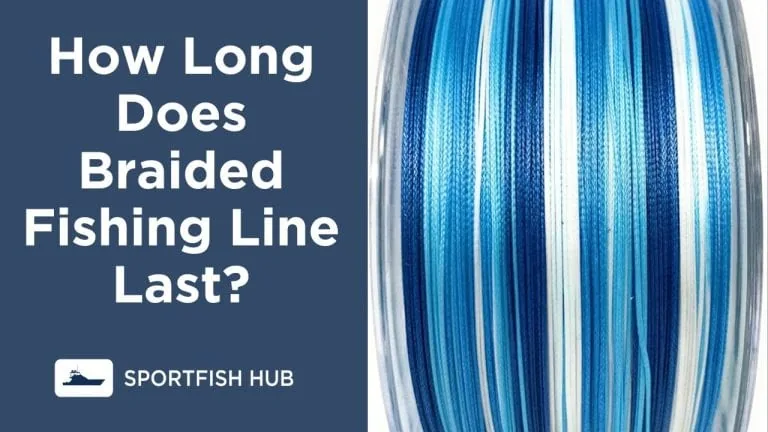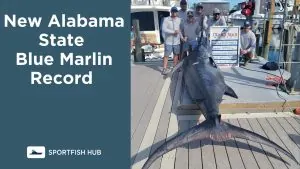Braided fishing line is a popular choice among anglers due to its strength, durability, and long lifespan. However, the question often arises, “How long does braided fishing line last?”
This comprehensive guide will provide insights into the lifespan of braided fishing line, factors affecting its longevity, and best practices for maintenance and storage.
The lifespan of Braided Fishing Line
Braided fishing line can last for many years if taken care of properly. A quality braid line, with proper care and maintenance, can last anywhere from 2 to 5 years. However, there are some scenarios when you would need to change it out, such as when a lot of line is frayed or you don’t have much braid left on your spool.
Braided line is heat and water-resistant and won’t break down when exposed to light, but its fibers could unravel or tangle, which weakens the line. Braided lines also don’t fare well against abrasion and will likely collapse if any of their strands erode, tear, or break.
Proper Maintenance of Braided Fishing Line
Maintenance is key in making your fishing line last as long as possible. Here are some tips to help you maintain your braided fishing line:
- Store it properly: While braided line is typically quite hearty and can withstand UV rays, it’s still a good idea to store it in a cool, dry, and dark place, out of direct sunlight.
- Clean it regularly: After each use, rinse your braided line with fresh water to remove any dirt, debris, or saltwater that may have accumulated on it. You can also use mild soap to clean it if necessary.
- Avoid sharp objects: Braided lines don’t fare well against abrasion and will likely collapse if any of their strands erode, tear, or break. If you are fishing around jagged structures, braid is not your best bet unless you are using a significant mono topshot.
- Cut it properly: Don’t expect to cut braided line with the common clippers that are so effective on nylon. If you need to cut your braided line, use scissors or a specialized braided line cutter.
- Check for frays: Check your braided line regularly for any frays or damage. If you notice any frays or damage, it’s time to replace your line.
Storing Braided Fishing Line
Proper storage is crucial to extending the life of your braided fishing line. Here are some tips for storing your braided fishing line:
- Keep it dry: Store your braided line in a cool, dry, and dark place, out of direct sunlight. This will help protect your line from humidity and sunlight, which can damage the line over time.
- Store it in a container: Store your braided line in a closed container, such as a tackle box or container. This will help keep the line covered and prevent it from getting tangled.
- Avoid sharp objects: Braided lines don’t fare well against abrasion and will likely collapse if any of their strands erode, tear, or break. Avoid storing your braided line near sharp objects that could damage it.
- Use a line spooler: Using a line spooler can help you store your braided line more efficiently and prevent it from getting tangled.
- Check it regularly: Check your braided line regularly for any frays or damage. If you notice any frays or damage, it’s time to replace your line.
Inspection of Braided Fishing Line
Braided fishing line can last for several seasons, and there’s no reason to replace it within a year. While it’s durable and can last longer than both mono and fluorocarbon, it’s important to inspect it regularly for signs of wear and tear because nothing on the water is guaranteed!
The frequency of inspection depends on how often you use your line and the conditions in which you fish. A good rule of thumb is to inspect your braided line after every fishing trip and check for any frays or damage. If you notice any frays or damage, it’s time to replace your line. Additionally, you should cut off and retie any time you see any sort of wear in the line.
What Are The Pros and Cons of Braided Fishing Line?
Pros of braided fishing line:
- Superior strength and durability: Braided line offers exceptional tensile strength and abrasion resistance, allowing for confident hook sets and fishing in rugged environments.
- Enhanced sensitivity and responsiveness: The low stretch nature of braided line provides excellent sensitivity, enabling anglers to detect even the slightest nibble and feel subtle underwater movements.
- Long casting distance and accuracy: With its thin diameter and minimal line memory, braided line allows for longer, more precise casts, reaching distant targets with ease.
- High visibility options for bite detection: Available in various vibrant colors, braided line offers excellent above-water visibility, aiding in detecting bites and managing line movement.
- Versatility across fishing techniques: Braided line is suitable for a wide range of fishing techniques, including lure fishing, trolling, and saltwater angling, making it a versatile choice for anglers.
Cons of braided fishing line:
- Limited stretch can lead to line breakage: The low stretch property of braided line, while advantageous for sensitivity, can increase the risk of line breakage when dealing with powerful fish or sudden aggressive strikes.
- Increased visibility underwater: Brightly colored braided line may be more visible to fish underwater, potentially making them more cautious or reducing bites in clear water conditions.
- Challenges in knot tying: Some braided lines can be trickier to tie knots with, requiring specific knot types or additional steps to ensure optimal knot strength.
- Higher price compared to other line types: Braided line tends to be more expensive than monofilament or fluorocarbon lines, which should be considered for anglers on a budget.
What is Braid Fishing Line Used For?
Braid fishing line is best used for various fishing situations and techniques. Its main advantages include high strength, sensitivity, and minimal stretch. Here are some common uses for braid fishing line:
- Heavy Cover Fishing: Braid excels in heavy cover situations such as fishing around thick vegetation, fallen trees, or rocky structures. Its abrasion resistance and strength help anglers navigate through dense cover and prevent line breakage.
- Saltwater Fishing: Braid is highly popular among saltwater anglers due to its durability, resistance to saltwater corrosion, and excellent casting distance. It is suitable for targeting species like tuna, tarpon, and large game fish.
- Deepwater Fishing: Braid has a thin diameter compared to its strength, making it ideal for deepwater fishing where you need to reach greater depths quickly. Its minimal stretch allows for better sensitivity and enhanced feel of subtle bites or changes in bottom structure.
- Topwater Fishing: Braid is commonly used for topwater fishing techniques like walking the dog or popping. Its low stretch allows for quick and precise rod movements, enhancing lure action and increasing hook-setting power.
- Vertical Jigging: Braid’s sensitivity and strength make it a preferred choice for vertical jigging. Anglers can feel even the lightest strikes and effectively work the lure up and down vertically.
- Spinning Reels: Braid is often preferred for use on spinning reels due to its limpness and the ability to cast farther with lighter lures. It also has a higher line capacity, allowing for longer fights with powerful fish.
FAQ
Do fish notice braided line?
Yes, fish can notice braided fishing line to some extent due to its higher visibility in the water compared to other types of fishing line.
Can you use a braided line on a spinning reel?
Yes, you can use braided fishing line on a spinning reel.
Is four strand or eight strand braid better?
The choice between 4-strand and 8-strand braided fishing line depends on personal preference and fishing conditions. Generally, an 8-strand braided line offers better strength, durability, and casting performance compared to a 4-strand. However, 4-strand may be more affordable and suitable for certain fishing situations.
Conclusion
In conclusion, with proper care, maintenance, and storage, braided fishing lines can serve anglers for many years, making them a cost-effective choice in the long run. Regular inspection and prompt replacement of damaged lines will ensure you get the most out of your investment.












